In this tutorial, we will learn about Synchronization of Generators. Often electrical generators are removed from the service and connected back to the power system during variations of the load, emergency outages, maintenance, etc. Every time before reconnecting the generator to the system, it must be synchronized with parameters of the power system network.
An improper synchronization can affect the healthy power system and results in electrical and mechanical transients that can damage the prime mover, generator, transformers and other power system components.
Outline
ToggleWhat is Synchronization of Generators?
The process of matching parameters such as voltage, frequency, phase angle, phase sequence and waveform of alternator (generator) or other source with a healthy or running power system is called Synchronization of Generators.
A Generator cannot deliver power to electric power system unless its voltage, frequency and other parameters are exactly matched with the network. Synchronization is accomplished by controlling the exciter current and the engine speed of the generator.
The need for synchronization arrives, particularly when two or more alternators are working together to supply the power to the load. This is because electrical loads are not constant and they vary with time (depending on the load) and hence it is necessary to interconnect two or more alternators operating in parallel to supply larger loads.
Synchronization matches various parameters of one alternator (or generator) to another alternator or to the bus bar. The process of synchronization is also called as Paralleling of Alternators or Generators.
Need of Paralleling of Generators
In most commercial power plants, several small units supply the power rather than single large unit. This is called as Parallel Operation of Generators. The reasons for preferring this practice are enumerated below.
Reliability
Several small units are more reliable than single large unit. This is because, if one alternator is failed, other alternators are still active and hence the whole system will not be shutdown.
Continuity of Service
In case of periodic maintenance, break-down or repairs of one alternator, it must be shutdown and removed from service. Since the other machines are operating in parallel, the interruption to supply the load is prevented.
Load Requirements
The load requirements in the central station changes continuously. During light-load periods, only one or two generators are operated to supply the load demands. During peak-load demands, additional alternators are connected in parallel to meet the demand.
High Efficiency
Generators run most efficiently when they are loaded at their rated values. Due to the operation of few generators at light-loads and more generators at high peak loads efficiently loads the generators.
Expanded Capacity
As the demand for electric power is increasing continuously, utility companies have been increasing the physical size of the generating plants by adding more alternators. So, these alternators have to be connected in parallel with the existing generator equipment.
Conditions for Synchronization or Paralleling of Generators
There are certain requirements that must be met for successful paralleling of alternators. The following conditions must be met in order to synchronize a generator to the grid or with other generators.
Phase Sequence
The phase sequence of the three phases of the alternator which is being connected to the power system bus must have the same phase sequence as that of the three phases of the bus bar (or electric grid). This problem comes mainly in the event of initial installation or after maintenance.
Voltage Magnitude
The RMS voltage of the incoming alternator should be same as the RMS voltage of the bus bar or electric grid. If the incoming alternator voltage is more than the bus bar voltage, there will be a high reactive power that flows from the generator into the grid.
If the incoming alternator voltage is lower than the bus bar voltage, generator absorbs the high reactive power from the bus bar.
Frequency
The frequency of the incoming generator must be equal to the frequency of the bus bar. Improper matching of frequency results in high acceleration and deceleration in the prime mover that increases the transient torque.
Phase Angle
The phase angle between the incoming generator voltage and voltage of the bus bar should be zero. This can be observed by comparing the occurrence of zero crossing or peaks of the voltage waveforms.
Procedure for Connecting Alternators in Parallel
When the above stated methods are fulfilled, the alternators are said to be synchronized. The actual process of synchronization or paralleling generators includes the following steps.
- Consider that alternator-1 is supplying power to the bus bars at rated voltage and frequency.
- Now, an incoming alternator-2 is to be connected in parallel with alternator-1 for the first time. By increasing the speed of the alternator, its frequency is varied and hence the speed is adjusted till it matches with bus bar frequency (or the frequency of alternator-1). Also, by varying the field rheostat, the voltage of the alternator-2 is varied and hence it is adjusted till the voltage matches with bus bar voltage.
- The three voltages generated by the alternator-2 must be in phase with the respective voltages of the bus bar (or alternator-1). This is achieved by maintaining the same phase sequence and frequency of alternator-2 with bus bar or alternator-1. For achieving these relationships, synchronizing lamps technique is used.
Different Techniques for Synchronization
There are different techniques being available for the synchronization of alternators. The primary purpose of these techniques is to check all four conditions discussed above. The common methods used for synchronizing the alternators are given below:
- Three Dark Lamps Method
- Two Bright, One Dark Method
- Synchroscope Method
Three Dark Lamps Method
The figure below shows the circuit for bright lamp method used to synchronize the alternators. Assume that alternator is connected to the load supplying rated voltage and frequency to it. Now the alternator-2 is to be connected in parallel with alternator-1.
Three lamps (each of which is rated for alternator terminal voltage) are connected across the switches of the alternator-2. From the figure, it is clear that the moment when all the conditions of parallel operation are satisfied, the lamps should be more or less dark.
To synchronize the alternator-2 with bus bar, the prime mover of the alternator-2 is driven at speed close to the synchronous speed decided by the bus bar frequency and number of poles of the alternator.
Now the field current of the generator-2 is increased till voltage across the machine terminals is equal to the bus bar voltage (by observing the readings on voltmeters).
If lamps go ON and OFF concurrently, indicating that the phase sequence of alternator-2 matches with bus bar. On the other hand, if they ON and OFF one after another, it resembles the incorrect phase sequence.
By changing the connections of any two leads of alternator-2 after shutting down the machine, the phase sequence can be changed.
Depending on the frequency difference between alternator-2 voltage and bus bar voltage, ON and OFF rate of these lamps is decided. Hence, the rate of flickering has to be reduced to match the frequency. This is possible by adjusting the speed of alternator by its prime mover control.
When all these parameters are set, the lamps become dark and then the synchronizing switch can be closed to synchronize alternator-2 with alternator-1.
The main disadvantage of this method is that rate of flickering only indicates the difference between the alternator-2 and the bus bar. But the information of alternator frequency in relation to bus bar frequency is not available in this method.
Suppose, if the bus bar frequency is 50Hz, the rate of flickering of lamps is same when the frequency of the alternator is either 51 or 49 Hz, as the difference in these two cases is 1Hz.
Two Bright and One Dark Lamp Method
The connections for this method are shown in figure below and it is useful in finding whether the alternator frequency is lower or higher than the bus bar frequency.
Here, the lamp L2 is connected across the pole in the middle line of synchronizing switch as similar to the dark lamp method, whereas the lamps L1 and L3 are connected in a transposed manner.
The voltage condition checking is similar to the previous method and after it, the lamps glow bright and dark one after another. The lower or higher value of alternator frequency in comparison with bus bar frequency is determined by the sequence in which the lamps become dark and bright.
The sequence of becoming bright and dark L1- L2 – L3 indicates that the incoming generator frequency is higher than the bus bar frequency. Hence, the alternator speed has to be reduced by prime mover control till the flickering rate is brought down to a small.
On the other hand, the sequence flickering L1- L3 – L2 indicates that incoming alternator frequency is less than that of bus bar.
Hence, the speed of the alternator is increased by the prime mover till the rate of flickering is brought down to as small as possible. The synchronizing switch is then closed at the instant when lamps L1 and L3 are equally bright and lamp L2 is dark.
The disadvantage of this method is that the correctness of phase sequence cannot be checked. However, this requirement is unnecessary for permanently connected alternators where checking of phase sequence is enough to be carried out for the first time of operation alone.
Synchroscope Method
It is similar to the two bright and one dark lamp method and indicates whether the alternator frequency is higher or lower than the bus bar frequency. A synchroscope is used for better accuracy of synchronization and it consists of two pairs of terminals.
One pair of terminals marked as ‘existing’ has to be connected across the bus bar terminals or to the existing alternator and other pair of terminals marked as ‘incoming’ has to be connected across the terminals of incoming alternator.
The synchroscope has circular dial over which a pointer is hinged that is capable of rotating in clockwise and anticlockwise directions.
After the voltage condition is checked, the operator has to check the synchroscope. The rate at which the pointer rotates indicates the difference of frequency between the incoming alternator and the bus bar.
Also, the direction to which the pointer rotates (to either fast or slow) gives the information, whether the incoming alternator frequency is higher or lower than the bus bar frequency and hence the pointer moves either fast or slow.
The appropriate correction has to be made to control the speed of the alternator so as to bring the rate of rotation of pointer as small as possible. Therefore, synchroscope along with voltmeters are enough for synchronization process. However, in most of the cases a set of lights along with synchroscope is used as a double-check system.
These are the methods of synchronizing the generators. This process must be done carefully to prevent the disturbances in the power system as well as to avoid a serious damage to the machine. Only three lamps methods are not preferred today due to less accuracy and manual operation.
These processes need a skilled and experienced person to handle the equipment while synchronizing. In most cases synchroscope method with set of lamps is used as mentioned above.
Modern synchronization equipment automates the whole synchronization process with the use of microprocessor based systems that avoids manual lamps and synchroscope observations. These methods are easier to manage and more reliable.
Conclusion
A beginner’s tutorial on the concept of Synchronization of Generators, the need for synchronization or paralleling of alternators (or generators), conditions to be met for proper synchronization, different techniques of synchronization along with their advantages and disadvantages.

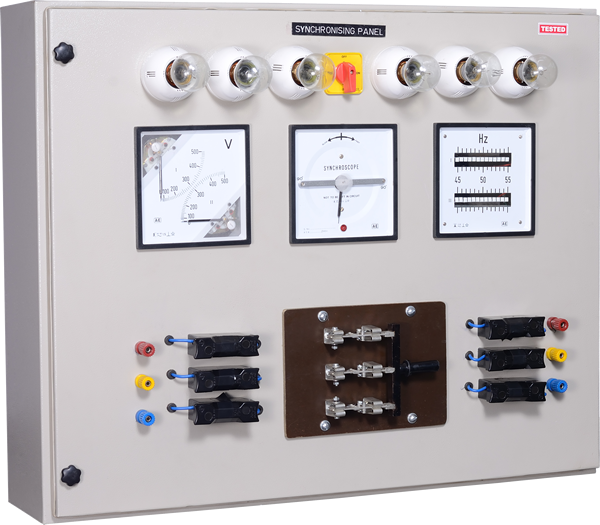
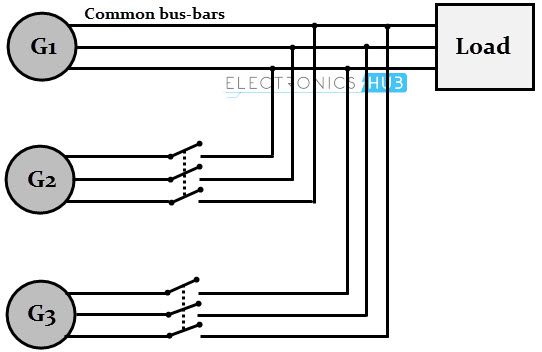

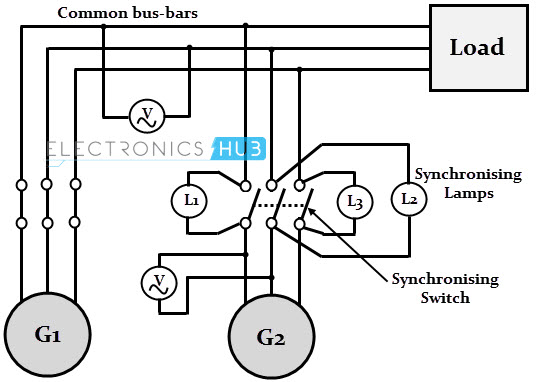
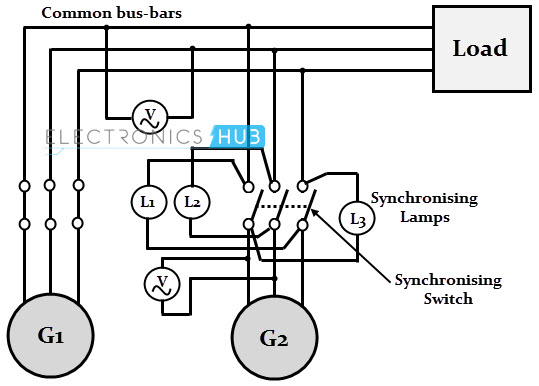
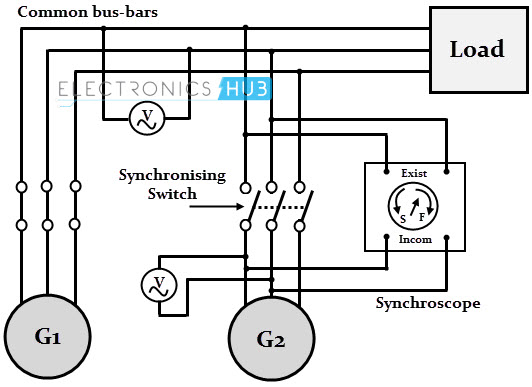

25 Responses
it is very nice information and useful to our project.so thank you!!!
Thank you.
Is it any method of synchronizing the two single-phase generators with AVRs?
I’d there a need to synchronize generators if they are ran by the same power unit
Very good explanation.. thank you
Thanq it’s very useful information to me.
Thanks a lot
I have cleared my concept after reading this great explaination…
Wonderful explanation Full fill & help full for project.
Very usefull can understand in a short period of time
Very good explanation.. thank you
Very useful topic. I would be appreciated if you could give me the name of auto-synchrocheck in the market used for small generator used in critical power application like data center or some other ordinary cases like shopping mall.
May I get any video for synchronization process explaining that, why pointer rotating clockwise / anti-clockwise, slow or fast rotating ? and for that cases what is my action (raise/lower speed/voltage) ?
Very good
Very nice, thanks for given useful information.
Very nice, thank given useful information
well illustrated.
is very clear information,
very good article,nice explanation
That good information, thanks d
If phase sequences are incorrect then by synchroscope method how will it be reflected?
Nice explanation,, helpful for all
Tnq
So nice
Excellently explained with well drawn diagrams
Thanks for your good explanation
Well explained in simplest word thats a double skill